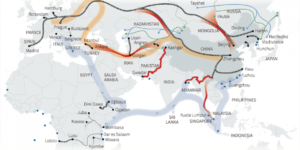Nov
3
China’s “Debt-Trap Diplomacy”
“Clearly, the Chinese Communist Party is eroding US economic influence abroad. The EXIM is one of our best tools to prevent this and keep America strong.” — Newt Gingrich
 Many of you might not realize (as I didn’t) that China has instituted something called the “Belt and Road Initiative” (BRI), by which it finances infrastructure and other investment projects across the globe. The official position is that it is purely for peaceful economic purposes, with the goal of building bridges (literally and metaphorically) and improving markets. Those who don’t buy the Communist Party line have suspected that its goal is more accurately “Chinese dominance in global affairs with a China-centered trading network.”
Many of you might not realize (as I didn’t) that China has instituted something called the “Belt and Road Initiative” (BRI), by which it finances infrastructure and other investment projects across the globe. The official position is that it is purely for peaceful economic purposes, with the goal of building bridges (literally and metaphorically) and improving markets. Those who don’t buy the Communist Party line have suspected that its goal is more accurately “Chinese dominance in global affairs with a China-centered trading network.”
There has also been suspicion that global military influence is also one of the initiative’s purposes. China, of course, has repeatedly denied any militaristic goals for the BRI. But, this past July, Chinese Defense Minister Wei Fenghe as much as admitted (in a speech to defense officials from Latin American, Caribbean, and South Pacific countries) that the military link is there. As reported by The Trumpet, Wei told attendees,
“‘The Chinese military stands ready to deepen mutual trust and consolidate friendship with the militaries of the Caribbean countries and Pacific Island countries.’ He added that such cooperation would take place within ‘the framework of the BRI.'”
[Side-note: I do not support The Trumpet‘s end-times claims/speculations, which are influenced by Armstrongism.]
Former Speaker of the House Newt Gingrich is very concerned about China’s growing influence around the world, which is why he wrote his new book, Trump vs. China: Facing America’s Greatest Threat. In an article published couple weeks ago, he discussed China’s use of the BRI to pressure countries that are hugely in debt to them to build or turn over control of military bases, energy plants, ports, etc.
 Gingrich summarized how this “debt-trap diplomacy” works, including examples:
Gingrich summarized how this “debt-trap diplomacy” works, including examples:
“China offers large loans to smaller, poorer countries in exchange for the country’s bolstering of Beijing’s strategic interests. Then, China takes control of the assets built with the money – ports, air fields, etc. – when the smaller countries can’t cover the debt. For one example, Sri Lanka signed a 99-year lease of its Hambantota port facilities over to China after it couldn’t pay China back for its initial loan. Right now, according to EXIM reports, eight more countries owe China. Two of these, Djibouti and the Maldives, are critical to China’s Maritime Silk Road (the BRI’s maritime route).
Again, this is not exclusively an economic strategy. The Wall Street Journal reported in late July that the Chinese were holding secret negotiations for exclusive military access to a part of the Ream naval base in Cambodia for the next three decades. The base is on the Gulf of Thailand and represents an important strategic point from which China could project power and influence in the South China Sea. This sort of activity is happening everywhere. For example, there are at least 46 existing or planned Chinese port projects in sub-Saharan Africa, as well.”
Though I didn’t use the term “debt-trap diplomacy”, regular readers might remember that I wrote about China’s efforts in this area in “What to Do About Africa” and quoted the Allahpundit talking about it in my “What About Greenland?” post.
China is also pushing their “Made in China 2025” strategic plan “to replace imported or acquired technology across 10 advanced manufacturing sectors and at least 70% Chinese domestic content by 2025 for select products. Gingrich elaborates…
“Many of these technologies have both civilian and military uses. This is not simply about continuing to dominate small electronics and cell phone manufacturing. This effort by China poses a potentially serious threat to our national security. According to the Pentagon, the dual-use nature of the ‘Made in China 2025’ program directly supports Chinese military modernization goals by stressing proprietary mastery of these technologies.”
 In addition, China uses its three Export Credit Agencies (ECAs) as a strategic arm for its “debt-trap diplomacy”. In fact, Gingrich points out that last year “China’s official ECAs outpaced the US Export-Import Bank (EXIM) by more than 100 fold (in terms of the amount of medium- to long-term credit it extended)…. So, compared to the United States, China is spending more, gaining more influence, and more quickly improving its economic and military positions across the globe.”
In addition, China uses its three Export Credit Agencies (ECAs) as a strategic arm for its “debt-trap diplomacy”. In fact, Gingrich points out that last year “China’s official ECAs outpaced the US Export-Import Bank (EXIM) by more than 100 fold (in terms of the amount of medium- to long-term credit it extended)…. So, compared to the United States, China is spending more, gaining more influence, and more quickly improving its economic and military positions across the globe.”
Gingrich strongly recommends that better use of the EXIM is the way to combat China’s efforts, though first Congress needs to pass the current proposal to renew its charter for 10 years.
“Congress should reauthorize the EXIM bank, so we can compete against the Chinese Communist Party’s economic strategy of world domination. The EXIM bank can level the playing field for US businesses, help them be more competitive, and ultimately help them create more US jobs. All the while, we will be strengthening our national security. For example, EXIM can help bolster the President’s ‘Prosper Africa’ initiative – which would directly compete with China’s aggressive activity there. This would be good for the US economically, militarily, and diplomatically….
Without EXIM, there is no practical, clear way to compete against the ever-expanding Chinese economic-military machine. If we do nothing, the Chinese Communist Party’s power will grow, our economic and national security interests will diminish, and our very way of life could be consumed by a totalitarian system.”
Now, I’m way out of my bailiwick here, and I acknowledge that there is some question in certain circles about whether the EXIM Bank should even be kept or dismantled. (From what little I’ve read, it sounds like at least some changes in practice need to be made — beginning with rethinking the wisdom of having China as its single biggest recipient.) But, Gingrich’s recommendation here sounds reasonable to me. The threat is certainly real enough. So, if there is an equally or more viable alternative, I’d be curious what it is.















